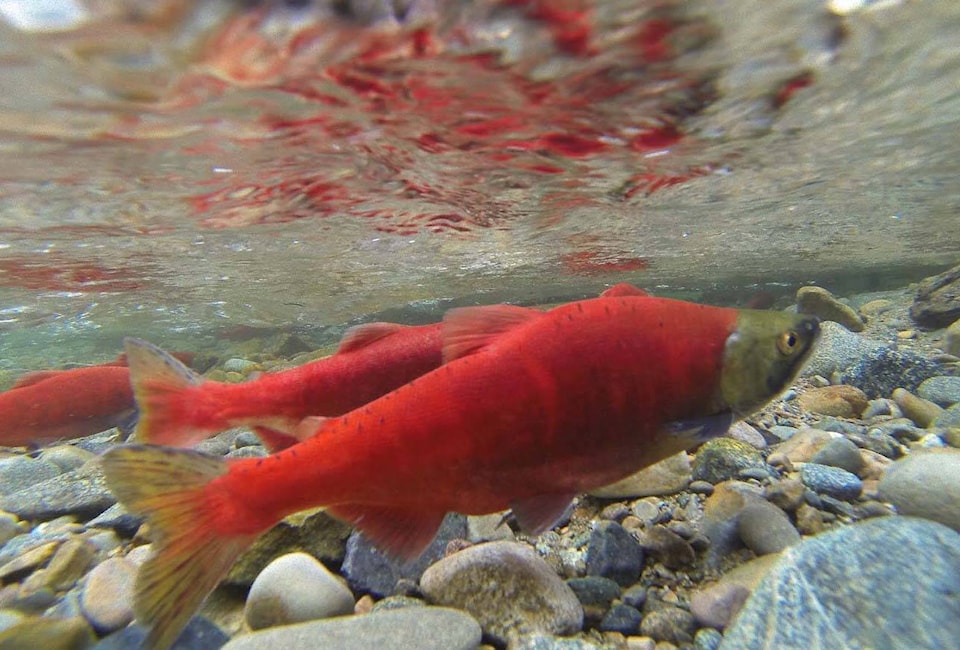by Bill Macpherson
West Arm Outdoors Club
Kokanee (Oncorhynchus nerka) are a member of the salmonidae family. They are the non-anadromous form of the sockeye salmon, meaning they do not migrate from the ocean to rivers. Instead they live out their entire lives in freshwater lakes like Kootenay Lake.
A healthy abundance of kokanee has always been a critical component to making Kootenay Lake the fishing destination it has been — they provided food for the prized Gerrard rainbow trout.
Gerrards are the largest rainbow trout in the world, named after the ghost town situated on the south end of Trout Lake where they spawn in a short 300-metre section of the Lardeau River.
They are unique, a sub-species found nowhere else in the world. With plenty of kokanee to eat, they grew to trophy sizes. Catches of 20-plus pound Gerrard rainbows were commonplace only three decades ago. Because of these special circumstances, Kootenay Lake has been long renowned for the quality of its fishery, with a well documented history of fisheries use.
Angler hours have previously been recorded at more than 200,000 in some years, making it an economically important recreational fishery. From 1960 through to the end of the last century, anglers from all over the world came to fish for the “Giants of Gerrard.”
The specific population of Kootenay Lake is nearly impossible to replicate by stocking in other lakes unless kokanee are present. Kokanee abundance has always been a key factor.
There are distinct differences between kokanee depending on what part of the lake anglers are on. West Arm kokanee are genetically distinct from main lake kokanee. They spawn at three years while main lake kokanee spawn at four years. There are also some distinct morphological features between the populations.
Historically the balance between predators and prey — rainbow and bull trout/kokanee — has fluctuated year-to-year but the ratio remained relatively constant. Early in the 2010s however, that balance was upset. It is a situation that remains to this day.
Human activities have caused long-term changes to the Kootenay Lake fishery over time. These include the introduction of mysis shrimp, fragmentation from dams and habitat impacts to spawning tributaries.
The catch limits regarding the key prey species, kokanee, have not been an issue when kokanee were abundant. As recently as 25 years ago, 15 kokanee were permitted daily on the main lake. Belatedly, this was reduced to five post-collapse and today no harvest is allowed.
Though major compensation works have been undertaken to restore or enhance optimal conditions for kokanee it remains an uphill struggle. A highly successful kokanee spawning channel at Meadow Creek and annual nutrient additions to the lake beginning in the early 1990s were two of the most important initiatives. They have certainly helped.
Even so, while it is normal for fisheries of large-bodied piscivores (rainbow and bull trout) and their prey (kokanee) to fluctuate — as populations decline or recover in abundance following variable natural conditions for growth and survival — the collapse of the kokanee numbers in Kootenay Lake in the early 2000s has resulted in what is called a “predator pit.” Simply put, the predators keep the prey in very low numbers.
In Kootenay Lake, the growth, survival and abundance of trophy-sized Gerrard rainbow trout and bull trout is undeniably linked to kokanee productivity. The effects of an over-abundance of predators has caused a collapse of prey, resulting in cascading ramifications negatively impacting the entire ecosystem. As predation levels remain high, the low kokanee numbers prevent breakout recovery.
The effect will be prolonged and severe given that the predators are usually much longer lived than their prey.
From the mid-1990s to the end of the decade there was an unprecedented abundance of kokanee (over one million) spawners annually. Predator numbers increased in the early 2000s and suppressed the kokanee population to historic lows of less than 50,000 spawners annually from 2015-2021.
The end result of this cataclysmic shift is a prolonged collapsed prey population. The collapse has been profound, severely impacting angler hours and eliminating, with rare exceptions, Gerrards of any significant size. Today, Gerrard trout seldom exceed five pounds. This has hurt businesses dependent on the historical renown of the Kootenay Lake fishery.
Can the kokanee recover to the numbers they have historically been?
With the expenditure of dedicated resources and, most important of all, proper management, the answer is yes: they probably can. What is required is a commitment and willingness to reduce predator spawners over the next few years. This key action will work in concert with incentives for anglers — a program now in its third year offering monthly and annual draw prizes administered by the West Arm Outdoors Club, with funding from the Habitat Conservation Trust Fund and other partners — continued nutrient additions, relaxed angler quotas on predators and increased kokanee egg stocking.
Over time, if these and other proactive measures are continued, the survival rate of juvenile kokanee will ensure a gradual increase in the population as predator numbers are kept in a reduced, though still healthy, state. The end result will be an eventual restoration of the proper predator/prey balance.
This will take time. It will be years before the current imbalance is resolved.
Eventually, a proper balance will bring about increased predator size. The uniqueness of the Kootenay Lake fishery — its trophy-sized Gerrard rainbow trout — will be restored to the glory of previous decades if an ongoing commitment to proper, necessary management actions is made.
